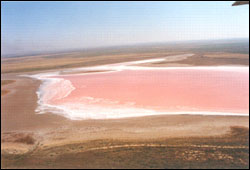Many implications seen for biomedical research
The human brain is estimated to contain 100 billion neurons (the number 1 followed by eleven zeros). Because a typical neuron forms ~1,000 synaptic connections to other neurons, the total number of synapses in the brain is estimated to be 100 trillion (the number 1 followed by 14 zeros). The thin projections from neurons that form connections with each other (axons and dendrites) can be thought of as the biological “wiring” of the br

Micro-organisms in salt lakes produce chlorinated air pollutants
Salt lakes have a greater impact on climate change than was previously understood. This has been established by scientists from the UFZ Centre for Environmental Research (Umweltforschungszentrum Leipzig-Halle) together with colleagues from Austria, Russia and South Africa. They found evidence that bacteria in salt lakes produce substances which act as greenhouse gases and destroy the ozone layer. These substances a
Measuring a biological chemical called hyaluronan found naturally in joints and the fluid that lubricates cartilage might enable doctors to diagnose osteoarthritis of the knee and hip earlier or more accurately, a new study concludes. Improving diagnosis of the painful inflammatory disorder should become increasingly important as baby boomer age, doctors say.
The research, conducted at the University of North Carolina at Chapel Hill and in Johnston County, N.C., revealed that leve
When scientists finished sequencing the genomes of seven species of fruit fly last year, little did they know that they had also sequenced the genes of several bacteria that dwell undetected inside fruit fly embryos.
The genes of these bacteria, from a genus Wolbachia that infects many insects, have been sitting in the fruit fly gene database since then, unnoticed, according to Michael B. Eisen, a UC Berkeley assistant professor of molecular and cell biology and a faculty scient
VLT NACO Performs Outstanding Observations of Titan’s Atmosphere and Surface
On January 14, 2005, the ESA Huygens probe arrived at Saturn’s largest satellite, Titan. After a faultless descent through the dense atmosphere, it touched down on the icy surface of this strange world from where it continued to transmit precious data back to the Earth.
Several of the world’s large ground-based telescopes were also active during this exciting event, observing Titan before and nea
Data from the Cassini-Huygens satellite showing oxygen ions in the atmosphere around Saturn’s rings suggests once again that molecular oxygen alone isn’t a reliable indicator of whether a planet can support life.
That and other data are outlined in two papers in the Feb. 25 issue of the journal Science co-authored by University of Michigan engineering professors Tamas Gombosi, J. Hunter Waite and Kenneth Hansen; and T.E. Cravens from the University of Kansas. The papers b